Quick start guide - LimeSurvey 3.0+/pl: Difference between revisions
From LimeSurvey Manual
(Created page with "Aby uzyskać dostęp do linku ankiety, musisz najpierw utworzyć instalację. Kliknij swoją nazwę użytkownika na głównym pasku narzędzi, a następnie przejdź do '' 'you...") |
(Created page with "Wybierz '' 'Instalacje' '' z menu profilowego znajdującego się po lewej stronie ekranu i utwórz instalację:") |
||
| Line 65: | Line 65: | ||
Wybierz '' 'Instalacje' '' z menu profilowego znajdującego się po lewej stronie ekranu i utwórz instalację: | |||
Revision as of 19:40, 31 July 2019
Wprowadzenie - czym jest LimeSurvey?
LimeSurvey jest darmową aplikacją ankietową online o otwartym kodzie źródłowym napisaną w PHP i rozpowszechnianą na zasadach licencji licencje / gpl-2.0.html GNU General Public License 2. Oprogramowanie umożliwia użytkownikom tworzenie i publikowanie ankiet online, zbieranie odpowiedzi, tworzenie statystyk i eksportowanie uzyskanych danych do innych aplikacji. Możesz zainstalować LimeSurvey na własnym serwerze (LimeSurvey CE) lub możesz bezpośrednio rozpocząć korzystanie z niego przez jedną z naszych usług hostingowych (LimeSurvey Pro).
Poniższy przewodnik początkowy opiera się na wykorzystaniu LimeSurvey Pro. Aby zainstalować LimeSurvey na własnym serwerze, sprawdź sekcję [1] z podręcznik LimeSurvey.
Utwórz darmowe konto LimeSurvey
LimeSurvey pozwala każdemu użytkownikowi utworzyć darmowe konto w celu przetestowania jego możliwości i podstawowych funkcji. Aby go wypróbować, najedź myszką na zakładkę „Pricing”, która znajduje się na górnym pasku narzędzi LimeSurvey i poszukaj linku o nazwie "Editions & Pricing" znajdującego się pod napisem "LimeSurvey Pro":

Pojawią się cztery opcje: "free", "basic", "expert" i "enterprise" . Kliknij przycisk "Register Now" w polu wyboru "Free option box":
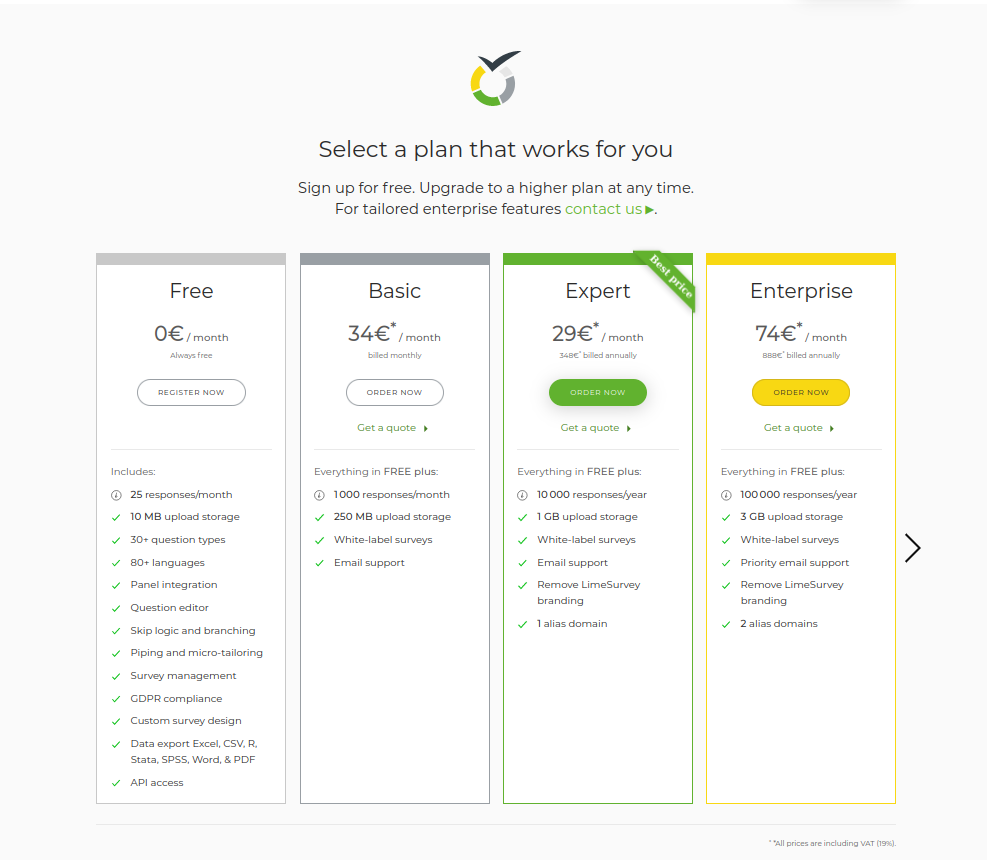
Następny krok obejmuje wypełnienie następujących pól:
- 'Nazwa użytkownika:' nazwa użytkownika twojego konta, która będzie również używana do uzyskania dostępu do instalacji LimeSurvey;
- 'Email:' adres e-mail, na który zostanie wysłana wiadomość z linkiem aktywacyjnym;
- 'Password:' hasło do konta, które będzie również używane do uzyskania dostępu do instalacji LimeSurvey.
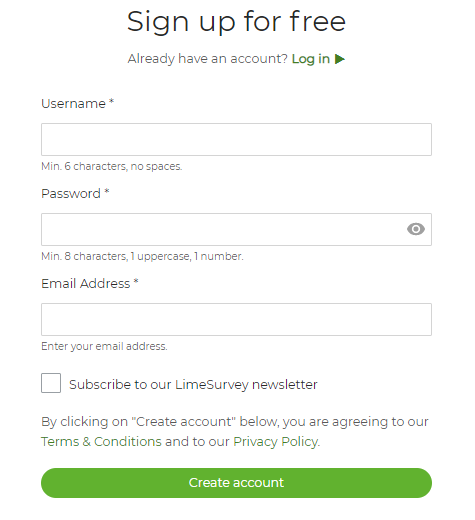
Po najechaniu myszką na każde z pól, pojawią się pola tekstowe z dalszymi szczegółami. Opcjonalnie możesz także subskrybować biuletyn LimeSurvey, aby uzyskać pomoc, porady i wskazówki, zniżki na usługi i najnowsze wiadomości.
! N! ! N! Aby przyspieszyć proces rejestracji, LimeSurvey pozwala każdemu użytkownikowi zarejestrować się za pomocą własnego konta Twitter, Gmail lub GitHub. LimeSurvey zbierze podstawowe informacje wymagane z wybranego źródła.
Po utworzeniu konta LimeSurvey, klikając przycisk „ZAREJESTRUJ SIĘ”, otrzymasz od nas wiadomość e-mail. Ta wiadomość zawiera link aktywacyjny, który należy kliknąć, aby uzyskać dostęp do nowo utworzonego konta. Po kliknięciu zostaniesz przekierowany na stronę LimeSurvey, automatycznie logując się do swojego konta LimeSurvey.
Aby uzyskać dostęp do linku ankiety, musisz najpierw utworzyć instalację. Kliknij swoją nazwę użytkownika na głównym pasku narzędzi, a następnie przejdź do 'your LimeSurvey profile' :

Wybierz 'Instalacje' z menu profilowego znajdującego się po lewej stronie ekranu i utwórz instalację:
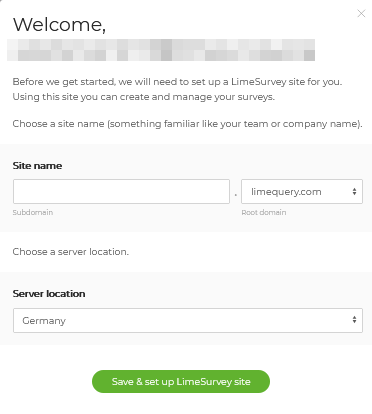
You will be asked to:
- type in the Domain name (the URL link of the questionnaire);
- choose the Server location – you can pick up one of the four server locations that will suit most of your needs.
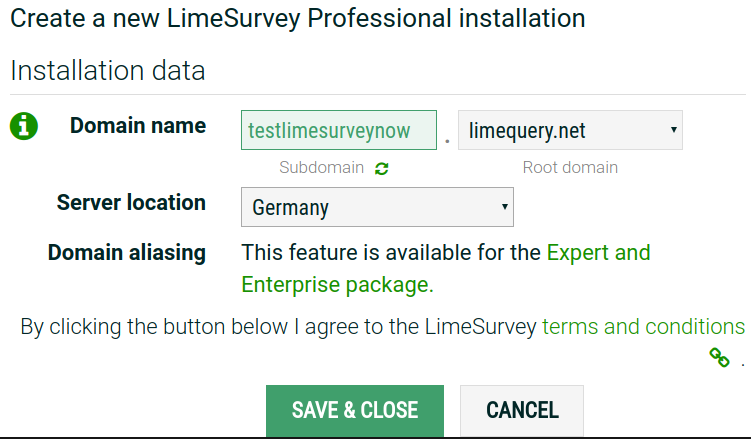
When the domain-related fields are completed and saved, the installation process will start. This will take up to 10 seconds. The installation settings page will look like this:
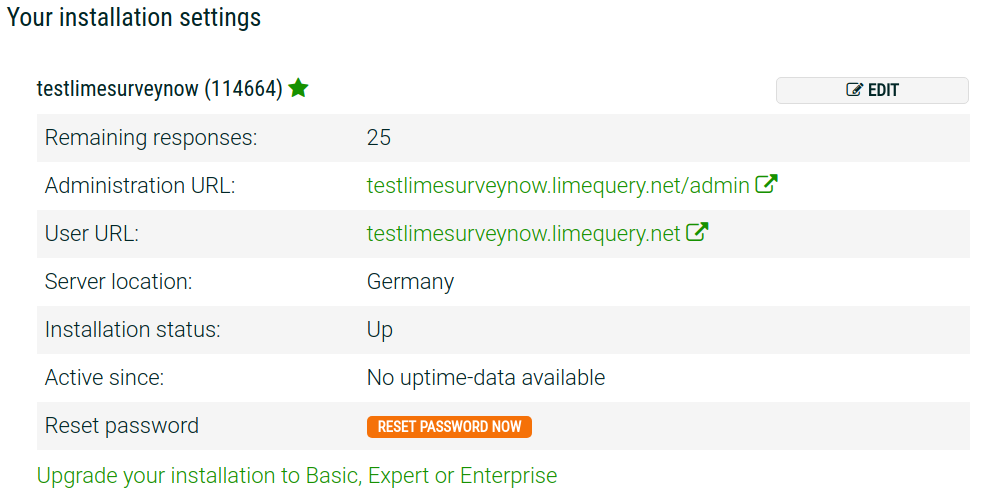
You can now access your server by clicking on the administration URL. To sign in to your LimeSurvey installation, use your LimeSurvey.org credentials:
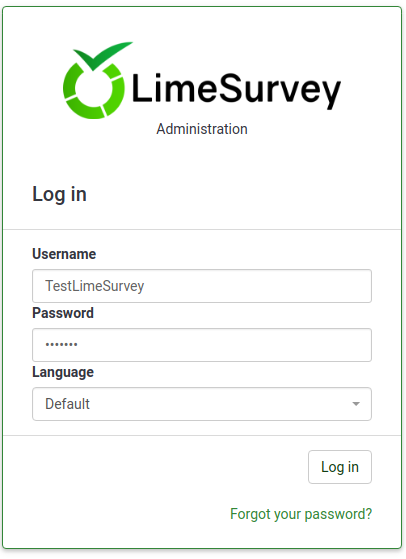
Start using LimeSurvey
Once logged in, you will find yourself on the home page of your LimeSurvey installation. It contains a toolbar located on the upper-right part of the window and a set of boxes, each of them corresponding to six LimeSurvey functionalities shortcuts, situated in the center of the home page.
The toolbar contains the following options:
- Tutorials: If you click on this option, you will get access to the in-built LimeSurvey tutorials. For example, one tutorial that can be accessed from any LimeSurvey 3+ installation is "Beginner Tour".
- Configuration: Once selected, a dialog will show up from where you can administrate your LimeSurvey installation.
- Settings: Under this tab, you may find options that can help you customize your LimeSurvey installation.
- Home page settings: Users can use this option to tweak the settings of the home page according to their needs;
- Global settings: The changes done here affect the entire LimeSurvey installation, influencing also the setting of non-superadministrator users for all users;
- Plugin manager: It allows every user to activate a series of plugins that are supported by the LimeSurvey team. New plugins can also be added to your installation.
- Users: Under this tab you may find options related to the management of he users and survey participants.
- Manage survey administrators: New administration users can be added from here;
- Create/edit user groups: This function is meant to group administration users in individual groups;
- Central participant database: It permits every administrator to store the participants' information to a central table/database that is independent of any table with survey participants.
- Advanced settings: It includes options that are non user- or survey settings-related. They can be used to enhance your LimeSurvey installation.
- Theme editor: Click on the following option if you would like to add/edit/delete survey themes, admin themes, or question themes. The themes allow control over the look and feel of pages of your survey or of your LimeSurvey GUI;
- Manage label sets: Label sets are basically list templates where each list has a set of codes with labels and it can be used in most question types either as answers or as subquestions;
- Check data integrity: It checks the consistency and the redundancy of the data;
- Backup entire database: It is used to backup the LimeSurvey data when important LimeSurvey upgrades are pushed or when you move your LimeSurvey installation to another server;
- ComfortUpdate: It is a tool utilized to easily update your LimeSurvey installation from your web browser with just a few mouse clicks (instead of performing a manual LimeSurvey reinstallation).
- Settings: Under this tab, you may find options that can help you customize your LimeSurvey installation.
- Surveys: A survey includes via different interconnected databases: languages, question groups, questions, question attributes, answers, subquestions, default answers, assessments, quotas, quota members, and quota language settings. By clicking on the green arrow, a window with the following options will load up:
- Create a new survey: New surveys can be created and added to the surveys list;
- Import a new survey: If you want to import a survey to your list of surveys, use this function;
- Copy a survey: It allows the user to quickly copy a survey. This will appear in the surveys list from where it can be edited;
- List surveys: It allows you you to get an overview on all the existing surveys.
- Response balance: It shows the number of responses left from your subscription. Because you have access only to a free account at the moment, 25 responses per month are available to you. If you run out of responses, purchase more from the following link;
- Storage: it represents the amount of MBs that are at your disposal to store your surveys and answers. Because you created a free account, you get 10 MB storage space. If you would like to receive more storage space, choose one of the following paid options from here;
- Username: By clicking on it, you can either access your user preferences or sign out from your account;
- Notifications: It is represented by the green bell - different notification related to your LimeSurvey installation will be displayed here.
There are six default boxes on the home page of your LimeSurvey installation:
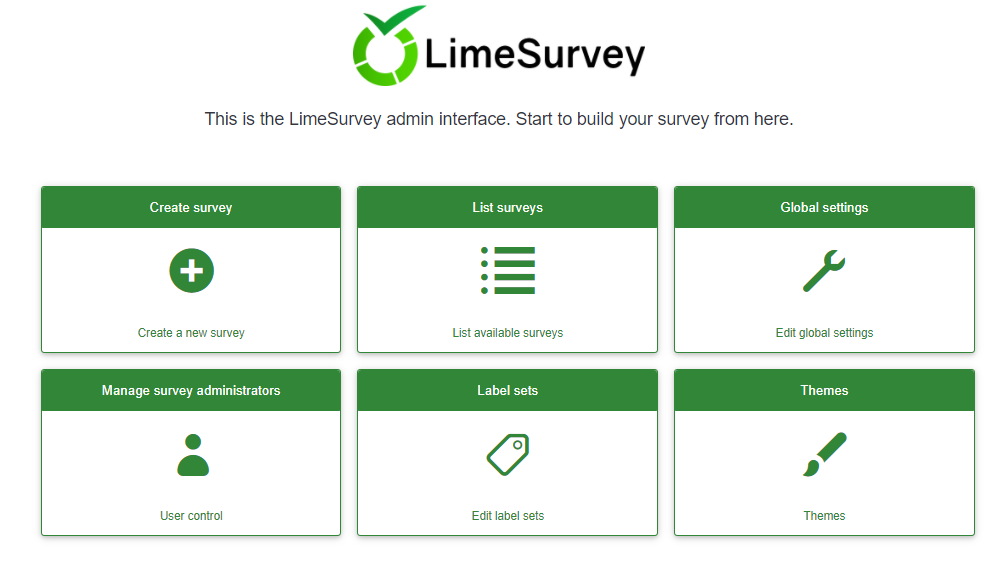
- Create survey
- List surveys
- Global settings
- ComfortUpdate
- Label Sets
- Themes
Create a survey
To create a survey, click on the Create a new survey box:
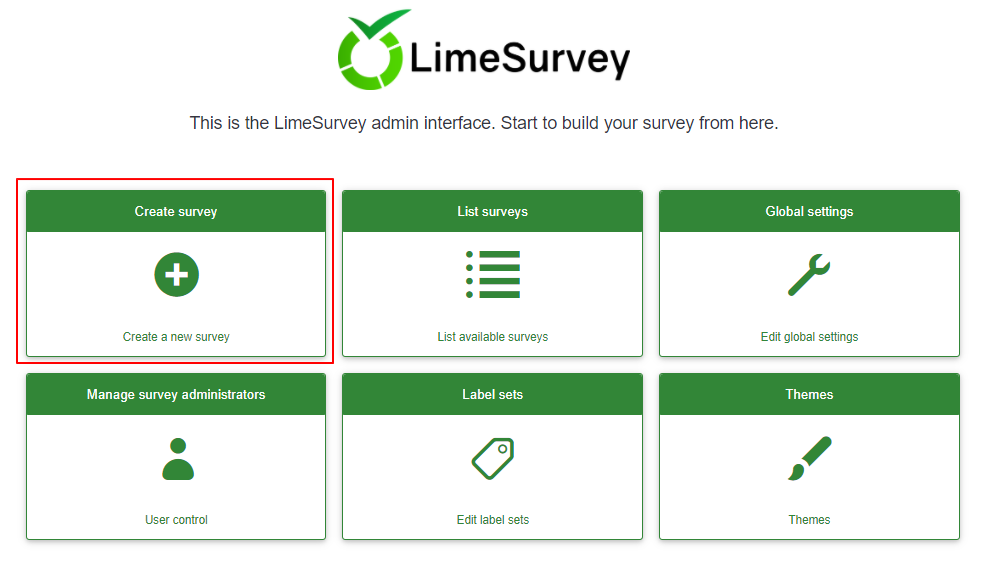
The Create survey page will be displayed:

The following options will be displayed:
- Survey title: The title of the survey has to be typed in here. You cannot proceed further if no name is given to your survey. No worrires if you do not feel inspired at the moment, the title of the survey can be changed later;
- Base language: It is the main language of the survey. Additional languages can be added later from the settings of the survey;
- Sample question: It comes disabled by default. If you enable it, a question group and question examples will be added to your survey;
- End URL: You have the possibility to redirect users to another page when they finish filling in the questionnaire. If you wish to redirect them, type in the URL and activate the automatically load URL option that is located under the Presentation & navigation tab;
- URL description: A short end URL description can be added in the case in which the user is redirected to a non-related survey webpage. It may help the survey administrator to add notes vis-a-vis the usage of the respective URL; ;
- Date format: This option is important when you want to record timestamps together with the survey participants' answers. If you click on it, a drop-down list will show up with a multitude of date formats. Choose the one that fits your survey respondents (do not forget that different date formats are used across the world);
- Decimal format: Two options are available: dot (.) and comma (,). Choose the one that fits the place where you conduct your study (e.g., US vs Germany);
- Description: A short description of the survey can be added here;
- Welcome message: The survey participants will be prompted by this welcome message if something is typed in;
- End message: Type in a message that will be displayed to the survey participants when they submit the answers to the questionnaire.
If you are done completing the fields, click on the Save and close button located in the upper-right part of the window. You will be redirected to the home page of your recently added survey:
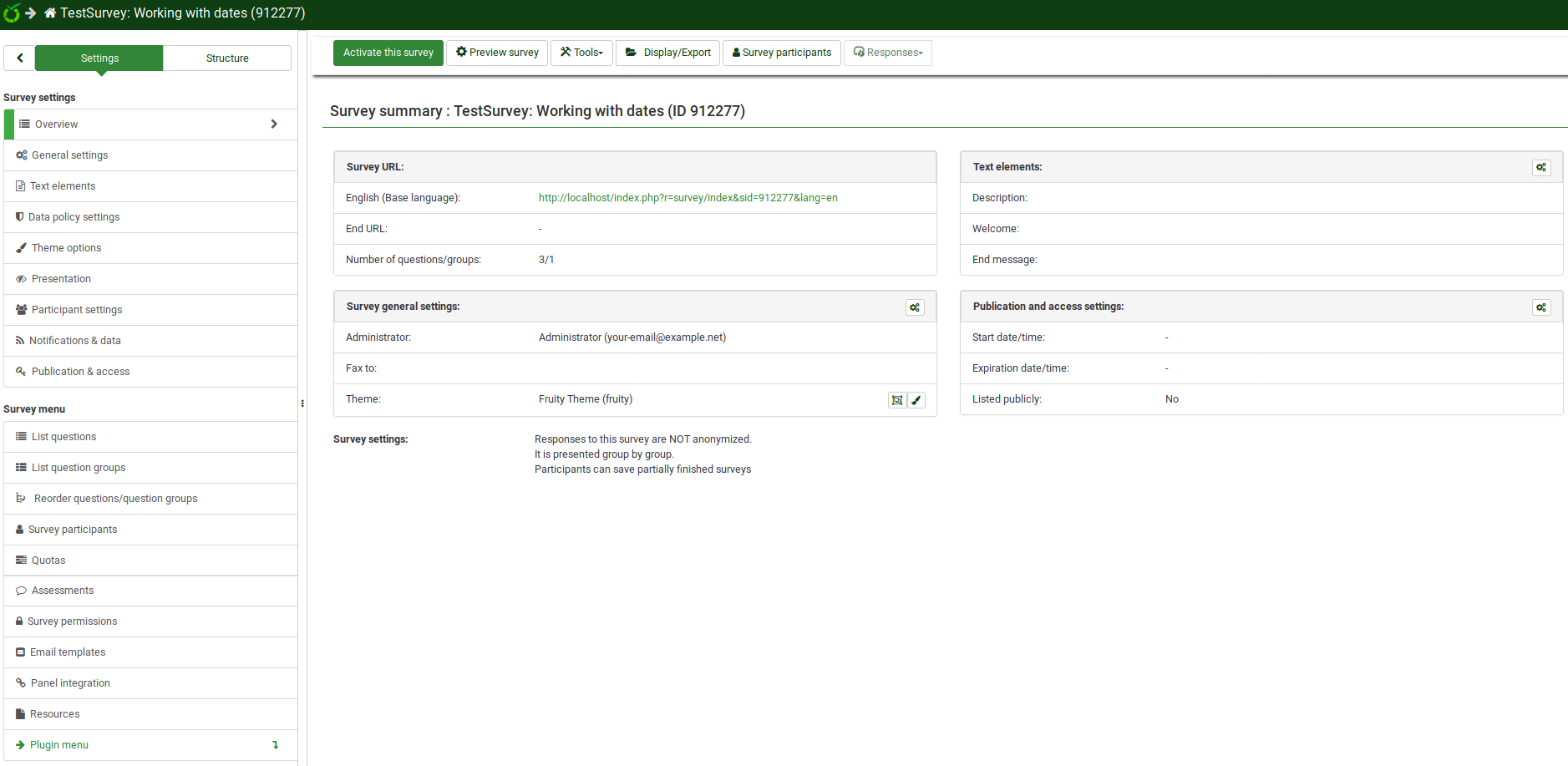
Create a question group
A question group is used to group different elements of a survey like descriptions, questions, and answers.
To create a question group, you have to first access the survey to which you want to add the question group. To do that, click on the Surveys button located on the top toolbar from the LimeSurvey home page:
Click on the survey you wish to add the question group to - the survey page will show up. The left-side menu contains two tabs: settings and structure. To add questions and question groups, you have to work from the structure tab:
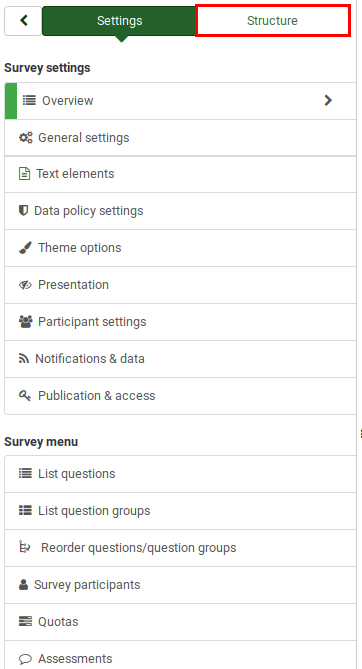
Once clicked on the Structure tab, the left-side menu will look like this:
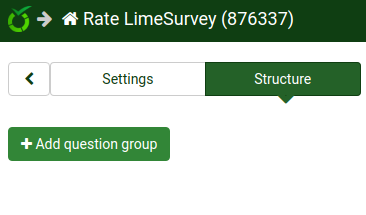
Now, click on the Add question group button. The following page will be displayed:
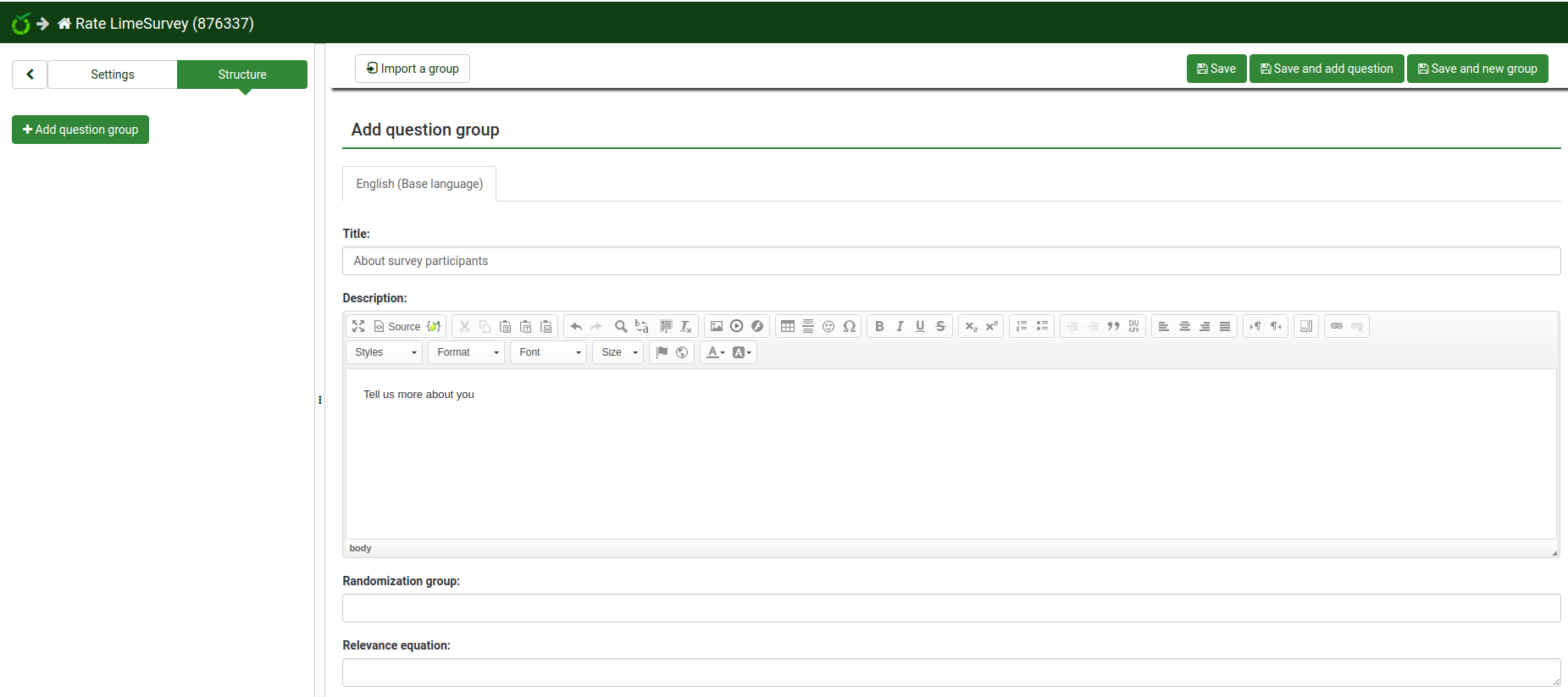
- Title: The name of the survey group;
- Description: A short description of the question group can be typed in. It can be displayed to the survey participants if the corresponding option is enabled from the settings of the survey;
- Randomization group: This function is used when you would like to randomize certain question groups (the same has to be allocated to the respective question groups);
- Relevance equation: It is used to make survey participants answer only to certain question groups, according to their prior answers.
Once done, click on the Save button located in the upper-right part of the window.
Create a question
To create a new question, always remember that you need first to create a question group. Please check the steps presented above to see how you can add a question group to a survey.
Once done creating the survey group, select again the structure tab and click on the add question button or select the question group from the left-side menu and click on the “add new question to group” button located under the Group quick actions:

Once clicked, the Create question page will load up. It contains the following options:
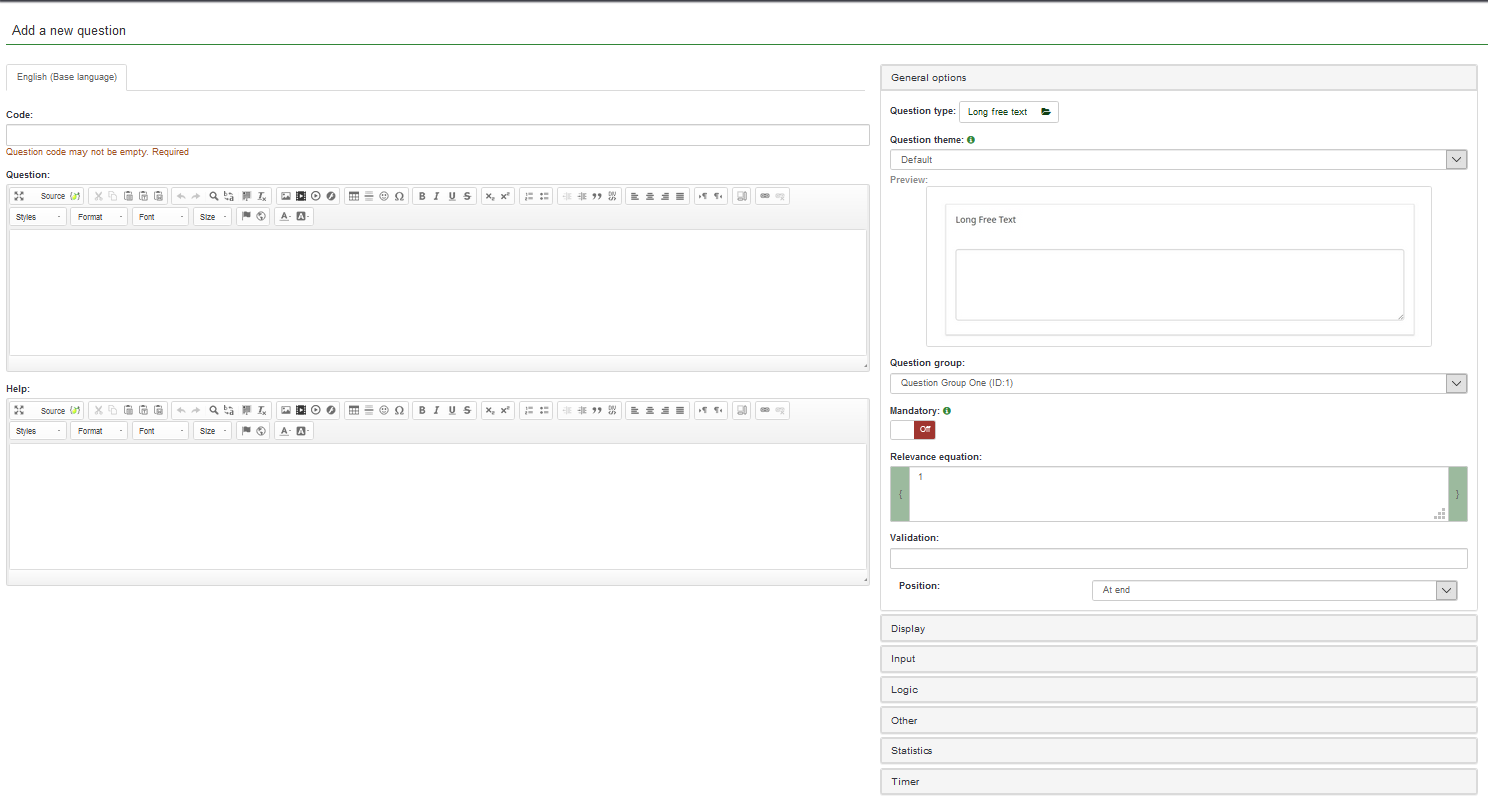
- Code: It represents the individual question name/code with which the survey is saved in the database and can be used further in more complex and advanced types of questions;
- Question: The name of the question that will actually appear in the survey for the survey participants;
- Help: A short text can be provided in order to help the survey participants better understand the question;
- General options: The functionalities located under this option allow you to modify the most important question-related settings. It includes four options:
- Question type: Many question types can be used in LimeSurvey. To better understand them, hover the mouse over each option or read our wiki on questions;
- Question group: You can choose here which question group you would like to add the question to;
- Validation: This feature is available on all free text type or numeric questions. It is used for response validation. If the response is not validated, the user will be prompted to try again before they can progress;
- Mandatory: It is available for all question types. This setting allows you to require users to answer the question before they can move on to the next question;
- Relevance equation: It is a setting for advanced users. It is recommended to use the default value of "1" (it means that the item will be always shown);
Please note that according to the selected question type, different tabs will be displayed below the General settings tab. To find out more on this, we suggest you to start reading first the following wiki section.
For example, if the Long free text question type is selected (the default option), then the following tabs will be displayed: General options, Display, Input, Logic, Other, Statistics, Timer. Click on the Save button. You will be redirected to a page that contains the summary of the recently added question:
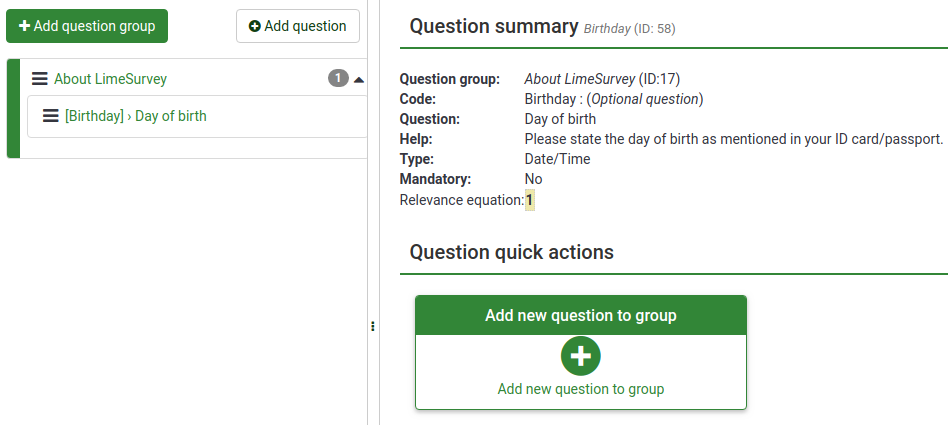
To add more questions, follow the same procedure described above.
Add subquestions and answers
Different types of questions require subquestions, predefined sets of answers, both or none. For example, a question that requires the age of a survey participant does not require any subquestion or predefined set of answers. On the other hand, a simple array question requires both subquestions and answers.
The next screenshot contains an array-type question:

Add subquestions
To add subquestions, go to the top toolbar and click on Edit subquestions. Type in the subquestions you wish the survey participants to answer to:

Add answers
To add a set of predefined answers, go to the top toolbar and click on Edit answer options. Type in the answers:

Save the set of answers and preview the question (look for the Preview question button located on the top toolbar).
Our question looks like this:

Congratulations! You have successfully created your first array-type question.
Organize questions
If your survey already contains dozens of questions, it is a time-consuming process to access each question and/or question group and edit the order one-by-one. Therefore, to quickly reorganize your questions and question groups, you can change the order of the questions and question groups from the Survey Structure menu. Once accessed, click on the three-lines symbol that is located in front of the question (group) name and start dragging it to the desired position.
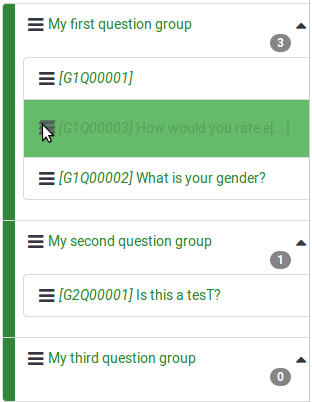
Activate/Stop survey
Now that you have at least one question and question group added to your survey, you can activate it. Select the Settings tab from the left-side menu and click on the Overview option. The following page will load up:
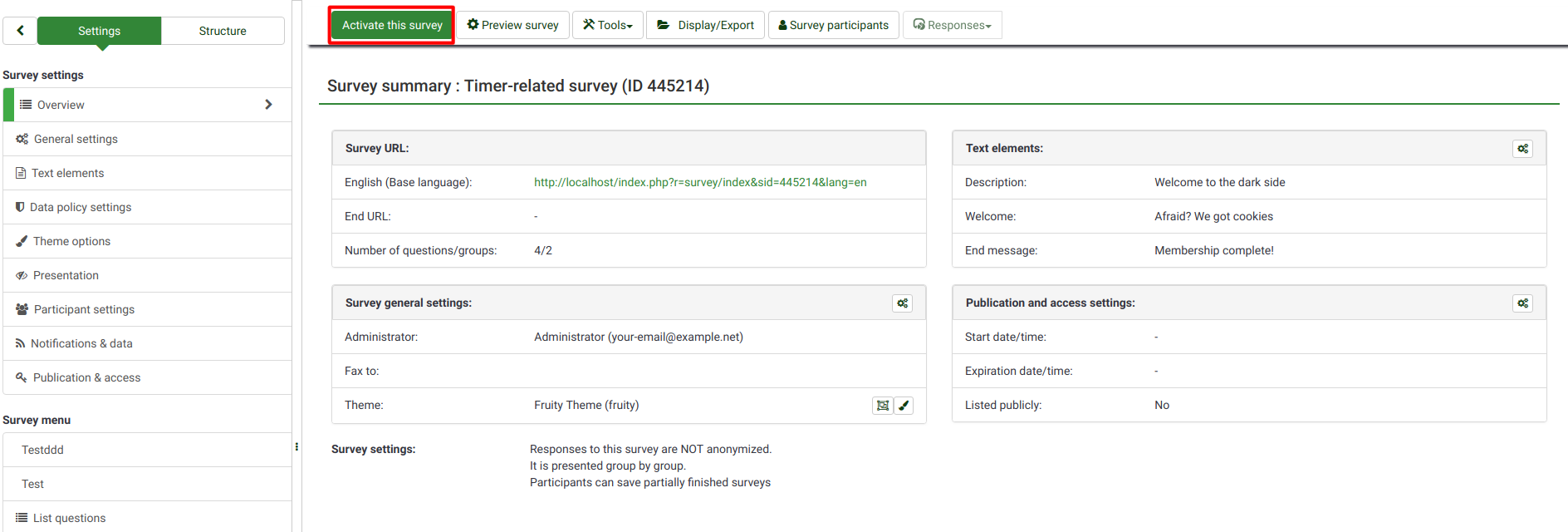
Check the toolbar and click on the Activate this survey button.
Before activation, a window will be displayed, asking you about some general survey settings:

- Anonymyzed responses: This option allows you to determine whether responses to your survey are matched up with information from your survey's token table, or kept "anonymous". If you decide to enable it, your survey is set to anonymize responses - there will be no way to connect answers and participants;
- Save IP address: If enabled, the IP address of the survey respondent will be stored together with his/her answers;
- Save timings: If enabled, the time spent on each page of the survey by each survey participant is recorded;
- Date stamp: Turn it on if you would like to see the date the answers were submitted;
- Save referrer URL: If enabled, the referrer URL will be stored together with the answers.
Once you are done enabling the desired functionalities, click on the Save & activate survey button. The following message should be displayed:

Select the option No, thanks to disable the closed-access mode! In this way, everyone will have access to your survey.
Congratulations! You have activated your first survey! If you want to start sharing the survey URL, go to the home page of your survey, and look for the survey URL in the Survey summary:
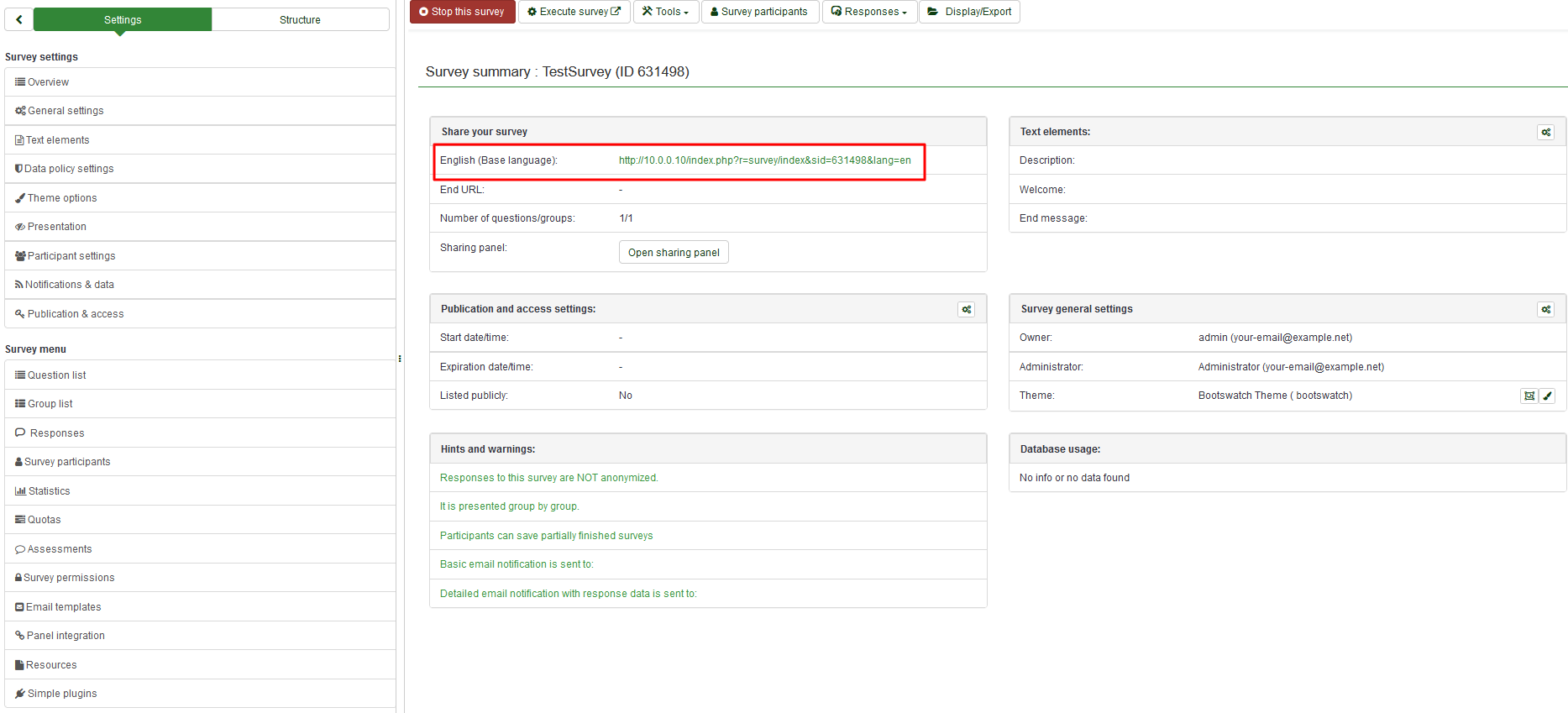
Copy the link and start sharing it.
If you want to stop the survey, click on the Overview tab from the left-side menu and look for the Stop this survey button located on the top toolbar:

Statistics
To quickly see your survey statistics, click on the Survey button located on the top toolbar of your LimeSurvey home page. A list with all the available surveys will be displayed. Now, go to the last column and click on the Statistics button (![]() ) that corresponds to the row of the survey you wish to analyse:
) that corresponds to the row of the survey you wish to analyse:

A new window with a set of graphs will be loaded up. If you want to use them in a report, scroll down and click on the Export images button located on the bottom-left part of the page. All the charts will be separately saved as .png files and archived in a .zip file.
On the upper-right part of the window, you can see the Expert mode button. Click on it in order to access more statistics-related filters.
Once you select the filters according to your desired analyses, click on the View Statistics button located on the upper-right part of the window.

According to the chosen output, the results are displayed in HTML, Excel or PDF.
Exporting the questions and responses
If you want to export the results in a different format in order to produce statistics and graphs using other apps such as SPSS, R, STATA, etc., access the survey you want to analyse. Click on the Responses button located on the top toolbar, and then on Responses & Statistics:

Now you are on the Browse responses page. Look at the top toolbar for the Export button and select the desired format you wish to export to. If you select the first option, all the availalbe formats in which you can export the data will be displayed:

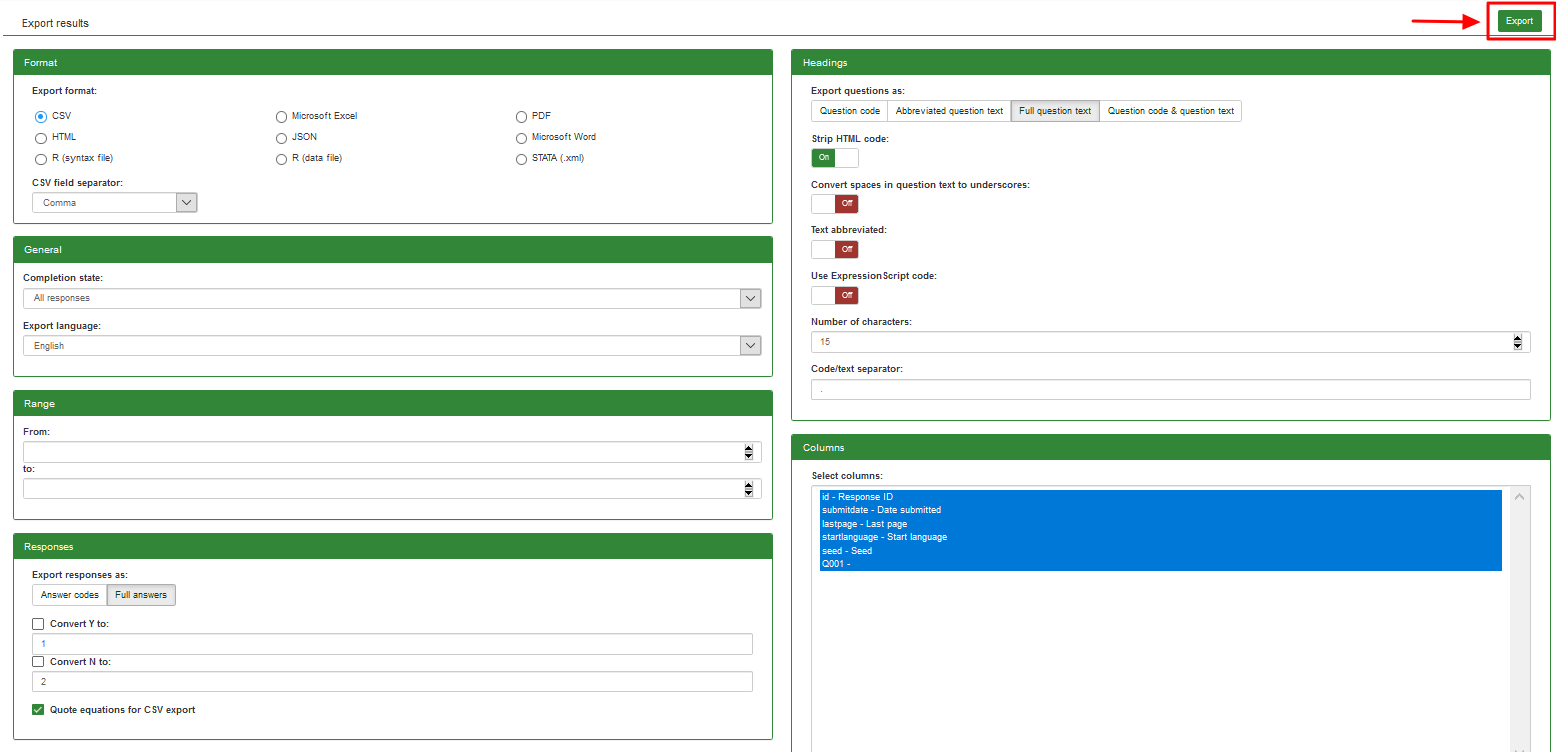
Once the filters are set, click on the Export button located in the upper-right side of the window.
Other LimeSurvey features - advanced users
Check the features of LimeSurvey Pro package by clicking on the following link: https://www.limesurvey.org/editions-and-prices/limesurvey-pro/professional-features.
If further questions arise, please post them on our forum or join the IRC channel.